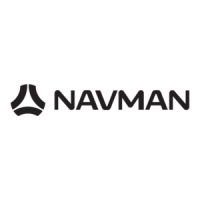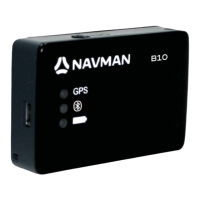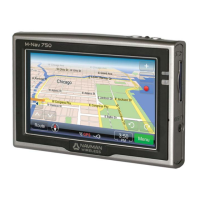Do you have a question about the Navman Tracker 5607 and is the answer not in the manual?
Regulatory compliance information regarding FCC rules for digital devices.
Regulatory compliance information for device operation in Canada.
General description of the NAVMAN 5507/5607's capabilities and design.
Instructions for safely cleaning and maintaining the display screen and unit.
Information on using C-MAP chart and user cards for navigation data.
Procedures for safely detaching and reattaching the display unit.
Explanation of key functions and how to use them for navigation and control.
Guide to navigating and interacting with the unit's menu system.
Manual and automatic power management procedures for the unit.
Adjusting screen brightness and enabling night mode for optimal viewing.
Procedure for activating the Man Overboard function to return to a lost position.
How the unit indicates alarm conditions and user settable alarms.
Using simulation modes for practice and familiarization without actual navigation.
Overview of accessing and switching between main display windows.
How to display and manage multiple windows simultaneously on the screen.
Creating and managing custom display layouts for quick access.
Customizing and displaying essential navigation data at the top of the screen.
Displaying compass information, including COG and BRG, on the chart.
Introduction to navigating by points and routes.
Step-by-step process for navigating to a specific waypoint or location.
Understanding the elements and display of the chart window.
Switching between boat-centric and cursor-controlled chart viewing modes.
Adjusting the zoom level and scale of the displayed chart.
Interpreting symbols and accessing information about chart objects.
Measuring distances and bearings between points on the chart.
Displaying estimated future position based on current speed and heading.
Recording and displaying the boat's movement history on the chart.
Viewing a list of entered waypoints with their details.
Comprehensive guide to creating, editing, and deleting waypoints.
Step-by-step instructions for adding new waypoints from chart or window.
Modifying waypoint data such as name, position, and type.
Removing waypoints from the system, with conditions for deletion.
Viewing a list of saved routes with their start, end, and distance details.
Comprehensive guide to creating, editing, and deleting routes.
Step-by-step instructions for building new routes from the chart or routes window.
Modifying existing routes by adding, moving, or removing waypoints.
Removing a specific route from the system.
Explanation of how the global GPS system functions for navigation.
Details on Differential GPS systems for enhanced position accuracy.
Information about the unit's GPS receiver capabilities and performance.
Choosing different pre-set gauge display configurations.
Customizing which data is shown on individual gauges.
Explanation of how the fuel computer estimates and displays fuel data.
Accessing and interpreting fuel status, speed, and flow information.
Procedures for accurately updating fuel levels after refueling or draining.
Setting up audible and visual alerts for low fuel levels.
Selecting and configuring boat speed sources for accurate calculations.
Understanding the difference between water and ground speed and their impact.
Creating and using curves to analyze and optimize fuel efficiency.
Calibrating fuel flow sensors for accurate readings.
Selecting the specific date for which tide data is displayed.
Viewing the list of files stored on the user card.
Transferring waypoints, routes, or tracks from the unit to the user card.
Importing data from the user card into the 5507/5607 unit.
Displaying information about detected AIS-equipped vessels on the chart.
Identifying potential collision risks based on TCPA and CPA values.
Accessing detailed AIS vessel information and managing message lists.
Viewing comprehensive data for a selected AIS vessel.
Overview of the Distress, Poll, and Buddy track display windows.
Displaying boats that have sent DSC distress messages.
Showing boats that have been manually polled via VHF radio.
Procedures for displaying, navigating to, creating waypoints for, and deleting boats.
Initiating navigation towards a selected boat's position.
System configuration options including language, backlight, and reset.
Chart display settings: rotation, palette, datum, and map shift.
Setting up GPS source, DGPS, static navigation, and filters.
Configuring fuel sensors, tank settings, and flow parameters.
Enabling and configuring various navigation and system alarms.
System configuration options including language, backlight, and reset.
Chart display settings: rotation, palette, datum, and map shift.
Applying minor positional adjustments to chart features.
Selecting chart display modes for different viewing scenarios.
Controlling waypoint visibility based on display options or routes.
GPS configuration: source, DGPS, static navigation, and filters.
Stabilizing speed and course readings when the boat is stationary or slow.
Fuel system configuration: sensors, tanks, flow, and economy settings.
Setting the averaging period for fuel flow readings to ensure stability.
Configuring track recording parameters, display, and memory usage.
Setting the frequency (time or distance) for recording track points.
AIS filtering, alarm settings, and projected course display.
Enabling alarms for vessels identified as dangerous based on TCPA/CPA.
Managing and resetting trip distance, total distance, and engine hours logs.
Enabling and configuring various navigation and system alarms.
Alarm triggered if the boat moves beyond a set radius from the anchor.
Setting display units for distance, speed, depth, fuel, and other measurements.
Configuring communication protocols (NMEA, NavBus) for data exchange.
Enabling NavBus connection for integrating NAVMAN instruments.
Calibrating speed, temperature, keel offset, and speed range sensors.
Calibrating the paddlewheel sensor for accurate speed readings.
Setting local time offset, time format, and date format.
Managing favorite display configurations for quick access.
Configuring simulation modes for practicing navigation features.
Simulating boat movement from a selected point with specified speed and heading.
List of items included in the 5507/5607 package.
Information on optional accessories like C-MAP cards and NavBus junction boxes.
Details on optional fuel sensors and engine types supported.
Diagram illustrating unit connections to GPS, power, and other instruments.
Guidelines for selecting a mounting location and mounting methods.
Instructions for installing the unit flush into a panel.
Wiring instructions for basic and auto power connections.
Selecting, installing, and configuring the GPS antenna.
Installing optional petrol/gasoline fuel flow sensors.
Installing optional diesel fuel flow sensors.
Connecting and configuring the unit with SmartCraft engines.
Connecting and integrating other NAVMAN instruments via NavBus.
Installing and setting up an optional NAVMAN VHF radio with NavBus.
Connecting and interfacing with instruments using the NMEA standard.
Finalizing installation, initial setup, and testing the unit's functionality.
Physical dimensions, display, backlight, and power specifications.
Communication protocols and standards supported (NavBus, NMEA).
Specifications related to chart cards, waypoints, routes, and chart datums.
Troubleshooting issues related to the unit not turning on or off.
Detailed steps to resolve power-on issues, checking fuses and connections.
Solutions for GPS fix issues, inaccurate positioning, and chart alignment problems.
Addressing issues with acquiring a GPS signal or long startup times.
Troubleshooting GPS position discrepancies and accuracy issues.
Solutions for inaccurate fuel readings, consumption, and economy data.
Diagnosing and resolving issues with inaccurate fuel flow sensor readings.
Alphabetical list of terms and their explanations.
Explanation of navigation data parameters like BRG, COG, SOG, and XTE.
Regulatory compliance information regarding FCC rules for digital devices.
Regulatory compliance information for device operation in Canada.
General description of the NAVMAN 5507/5607's capabilities and design.
Instructions for safely cleaning and maintaining the display screen and unit.
Information on using C-MAP chart and user cards for navigation data.
Procedures for safely detaching and reattaching the display unit.
Explanation of key functions and how to use them for navigation and control.
Guide to navigating and interacting with the unit's menu system.
Manual and automatic power management procedures for the unit.
Adjusting screen brightness and enabling night mode for optimal viewing.
Procedure for activating the Man Overboard function to return to a lost position.
How the unit indicates alarm conditions and user settable alarms.
Using simulation modes for practice and familiarization without actual navigation.
Overview of accessing and switching between main display windows.
How to display and manage multiple windows simultaneously on the screen.
Creating and managing custom display layouts for quick access.
Customizing and displaying essential navigation data at the top of the screen.
Displaying compass information, including COG and BRG, on the chart.
Introduction to navigating by points and routes.
Step-by-step process for navigating to a specific waypoint or location.
Understanding the elements and display of the chart window.
Switching between boat-centric and cursor-controlled chart viewing modes.
Adjusting the zoom level and scale of the displayed chart.
Interpreting symbols and accessing information about chart objects.
Measuring distances and bearings between points on the chart.
Displaying estimated future position based on current speed and heading.
Recording and displaying the boat's movement history on the chart.
Viewing a list of entered waypoints with their details.
Comprehensive guide to creating, editing, and deleting waypoints.
Step-by-step instructions for adding new waypoints from chart or window.
Modifying waypoint data such as name, position, and type.
Removing waypoints from the system, with conditions for deletion.
Viewing a list of saved routes with their start, end, and distance details.
Comprehensive guide to creating, editing, and deleting routes.
Step-by-step instructions for building new routes from the chart or routes window.
Modifying existing routes by adding, moving, or removing waypoints.
Removing a specific route from the system.
Explanation of how the global GPS system functions for navigation.
Details on Differential GPS systems for enhanced position accuracy.
Information about the unit's GPS receiver capabilities and performance.
Choosing different pre-set gauge display configurations.
Customizing which data is shown on individual gauges.
Explanation of how the fuel computer estimates and displays fuel data.
Accessing and interpreting fuel status, speed, and flow information.
Procedures for accurately updating fuel levels after refueling or draining.
Setting up audible and visual alerts for low fuel levels.
Selecting and configuring boat speed sources for accurate calculations.
Understanding the difference between water and ground speed and their impact.
Creating and using curves to analyze and optimize fuel efficiency.
Calibrating fuel flow sensors for accurate readings.
Selecting the specific date for which tide data is displayed.
Viewing the list of files stored on the user card.
Transferring waypoints, routes, or tracks from the unit to the user card.
Importing data from the user card into the 5507/5607 unit.
Displaying information about detected AIS-equipped vessels on the chart.
Identifying potential collision risks based on TCPA and CPA values.
Accessing detailed AIS vessel information and managing message lists.
Viewing comprehensive data for a selected AIS vessel.
Overview of the Distress, Poll, and Buddy track display windows.
Displaying boats that have sent DSC distress messages.
Showing boats that have been manually polled via VHF radio.
Procedures for displaying, navigating to, creating waypoints for, and deleting boats.
Initiating navigation towards a selected boat's position.
System configuration options including language, backlight, and reset.
Chart display settings: rotation, palette, datum, and map shift.
Setting up GPS source, DGPS, static navigation, and filters.
Configuring fuel sensors, tank settings, and flow parameters.
Enabling and configuring various navigation and system alarms.
System configuration options including language, backlight, and reset.
Chart display settings: rotation, palette, datum, and map shift.
Applying minor positional adjustments to chart features.
Selecting chart display modes for different viewing scenarios.
Controlling waypoint visibility based on display options or routes.
GPS configuration: source, DGPS, static navigation, and filters.
Stabilizing speed and course readings when the boat is stationary or slow.
Fuel system configuration: sensors, tanks, flow, and economy settings.
Setting the averaging period for fuel flow readings to ensure stability.
Configuring track recording parameters, display, and memory usage.
Setting the frequency (time or distance) for recording track points.
AIS filtering, alarm settings, and projected course display.
Enabling alarms for vessels identified as dangerous based on TCPA/CPA.
Managing and resetting trip distance, total distance, and engine hours logs.
Enabling and configuring various navigation and system alarms.
Alarm triggered if the boat moves beyond a set radius from the anchor.
Setting display units for distance, speed, depth, fuel, and other measurements.
Configuring communication protocols (NMEA, NavBus) for data exchange.
Enabling NavBus connection for integrating NAVMAN instruments.
Calibrating speed, temperature, keel offset, and speed range sensors.
Calibrating the paddlewheel sensor for accurate speed readings.
Setting local time offset, time format, and date format.
Managing favorite display configurations for quick access.
Configuring simulation modes for practicing navigation features.
Simulating boat movement from a selected point with specified speed and heading.
List of items included in the 5507/5607 package.
Information on optional accessories like C-MAP cards and NavBus junction boxes.
Details on optional fuel sensors and engine types supported.
Diagram illustrating unit connections to GPS, power, and other instruments.
Guidelines for selecting a mounting location and mounting methods.
Instructions for installing the unit flush into a panel.
Wiring instructions for basic and auto power connections.
Selecting, installing, and configuring the GPS antenna.
Installing optional petrol/gasoline fuel flow sensors.
Installing optional diesel fuel flow sensors.
Connecting and configuring the unit with SmartCraft engines.
Connecting and integrating other NAVMAN instruments via NavBus.
Installing and setting up an optional NAVMAN VHF radio with NavBus.
Connecting and interfacing with instruments using the NMEA standard.
Finalizing installation, initial setup, and testing the unit's functionality.
Physical dimensions, display, backlight, and power specifications.
Communication protocols and standards supported (NavBus, NMEA).
Specifications related to chart cards, waypoints, routes, and chart datums.
Troubleshooting issues related to the unit not turning on or off.
Detailed steps to resolve power-on issues, checking fuses and connections.
Solutions for GPS fix issues, inaccurate positioning, and chart alignment problems.
Addressing issues with acquiring a GPS signal or long startup times.
Troubleshooting GPS position discrepancies and accuracy issues.
Solutions for inaccurate fuel readings, consumption, and economy data.
Diagnosing and resolving issues with inaccurate fuel flow sensor readings.
Alphabetical list of terms and their explanations.
Explanation of navigation data parameters like BRG, COG, SOG, and XTE.
| Resolution | 480 x 272 pixels |
|---|---|
| Battery Life | Up to 3 hours |
| Waterproof | No |
| Bluetooth | Yes |
| Voice Guidance | Yes |
| Lane Guidance | Yes |
| Speed Camera Alerts | Yes |
| Device Type | GPS |
| Maps | Australia and New Zealand |
| Battery | Rechargeable lithium-ion |




